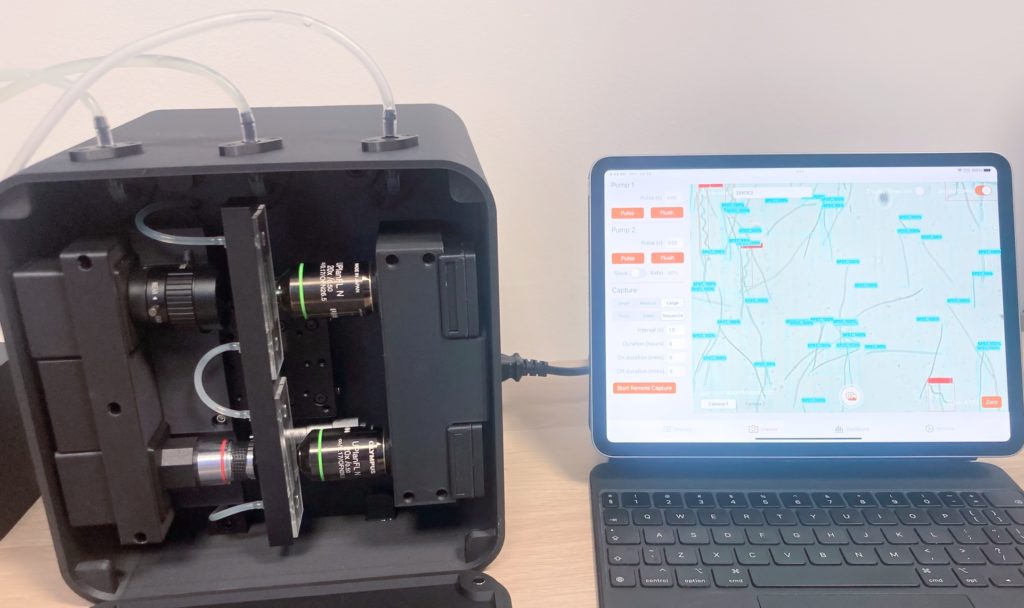
Microdeep™️
Microfluidics. Microscopy. Artificial Intelligence
Microdeep is the first microfluidics microscope allowing continuous measurements of the morphology and concentration of micro-organisms. While we started by focusing on micro algae, all organisms ranging between 1μm and 1mm are possible.
We have designed, manufactured and integrated a machine extremely simple to operate, yet completely versatile. This patent pending technology offers three layers in a single, small footprint package: a microscope, a simple fluidic network with two peristaltic pumps (one for the solution to analyze, one for eventual dilution), and electronics to manage the pumps and sensors, capture images and send them to an iPad or a Mac for processing.

Compact. Beautiful. Powerful.
The Microdeep unit is a 10” (22cm) cube that weights less than 5lb (2.5kg). Yet, we managed to fit a full microscope with outstanding optics, a camera, sensors, and peristaltic pumps in that small package.
Two peristaltic pumps ensure that you can dilute your solutions on the spot, as well as run cleaning procedures when the device is going idle.
Portable, minimal footprint: perfect for the lab, perfect for outdoors thanks to its rugged design using carbon-fiber composites.
We use high quality optics from Olympus and Thorlabs, with the possibility to integrate filters at the light source and before the camera sensor: bandpass filters, polarization filters, and color filters are available.
Monitoring cultures
This is the first application of Microdeep: monitoring the size (length and diameter) and shape of Spirulina filaments in cultures.
Our AI, tied to the dashboard, lets the user monitor the length, diameter and shape of the filaments: spiraled or straight, healthy or stressed, all at a glance.
These physiological parameters are tied to Microdeep’s sensors readings: temperature, pH, dissolved oxygen, redox potential and conductivity.
It all happens in real time, no internet connection required: the data is captured, analyzed on the fly, and results are available instantly, continuously.
We have models for Spirulina, Haematococcus, and deal with any spherical species as well: Chlorella, Dunaliella, Nanochloropsis and Pticochlorum to name a few we have tested.
AI for the rest of us
Microdeep is not limited to Spirulina detection. Actually, we are actively pursuing other species and/or models. Basically, anything that can be seen with a ×10, ×20, ×40 microscope objective can be identified and counted. Microdeep™️ uses state-of-the-art YOLO models for object detection. One can further use our ToolZ app to label data, export them in YOLO format to train a model, and import the resulting model in Microdeep.
We believe you do not need to be a computer scientist to use AI models on your Microdeep unit. Pick a model from our libraries, or bring your own. We made it easy: open the file browser dialog, select your model, and that’s all.
Here is a small model we recently built for a customer to detect Haematococcus algae. In this video we just change the model from our Spirulina detector to the Haematococcus detector. The app compiles the model, and we’re good to go.
Sensors Integration
Spirulina thrives in saline water (pH 10.3-10.5) and temperatures between 25-32℃. We added pH, temperature, a dissolved oxygen sensor, a redox sensor, and a conductivity sensor to monitor continuously the quality of water.
The same functionality is present in both the Dashboard and Readings views: pinching and swiping lets the user expand or contract the time axis, a really useful trick to detect when a problem occurred.
Of course, the sensors are integrated not only in the hardware, but also in the software: we have made it quick and easy to calibrate them.
The goal is simple: monitor your medium, conditions, the growth of the algae, and all that is left is to optimize the nutrients.
